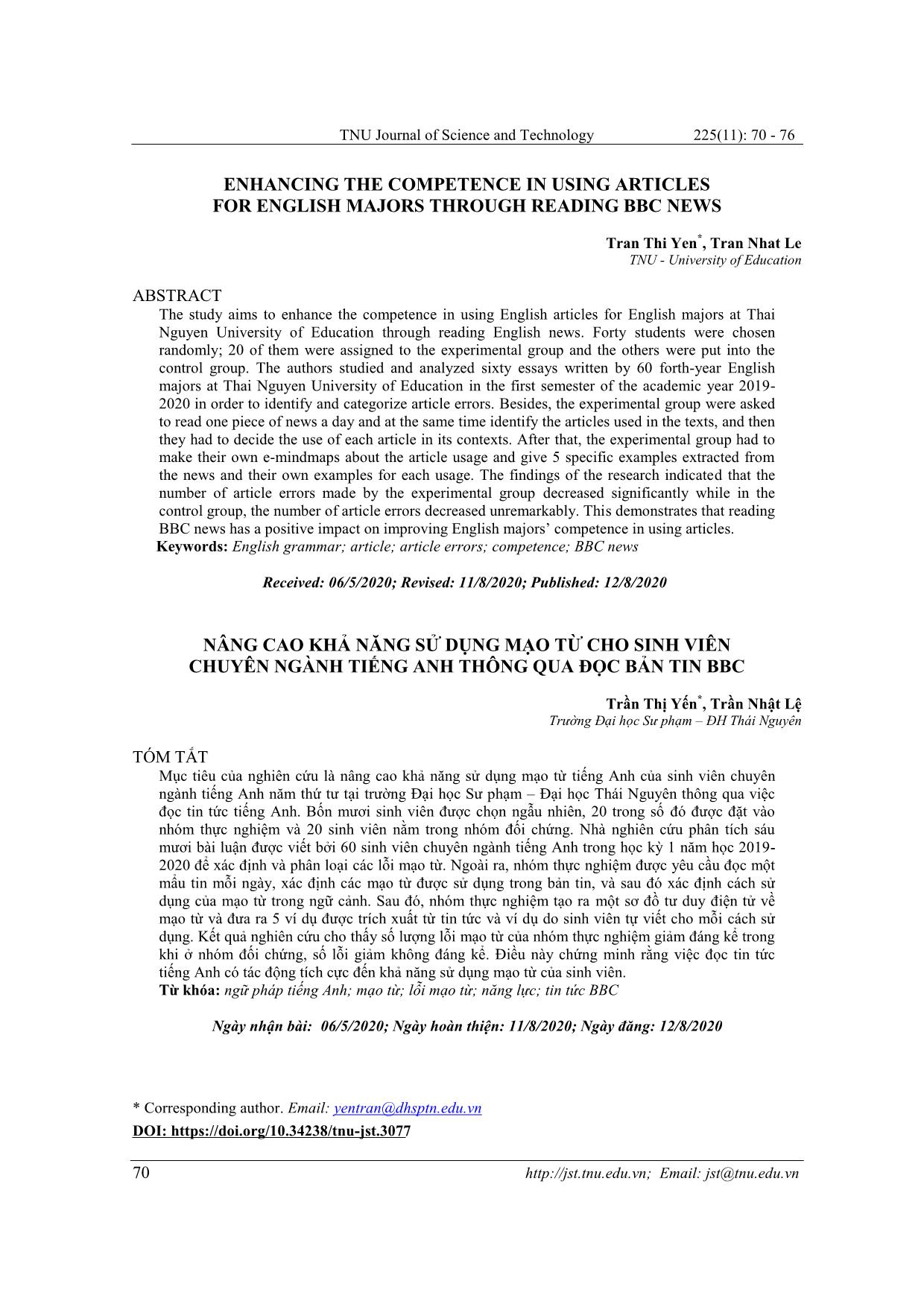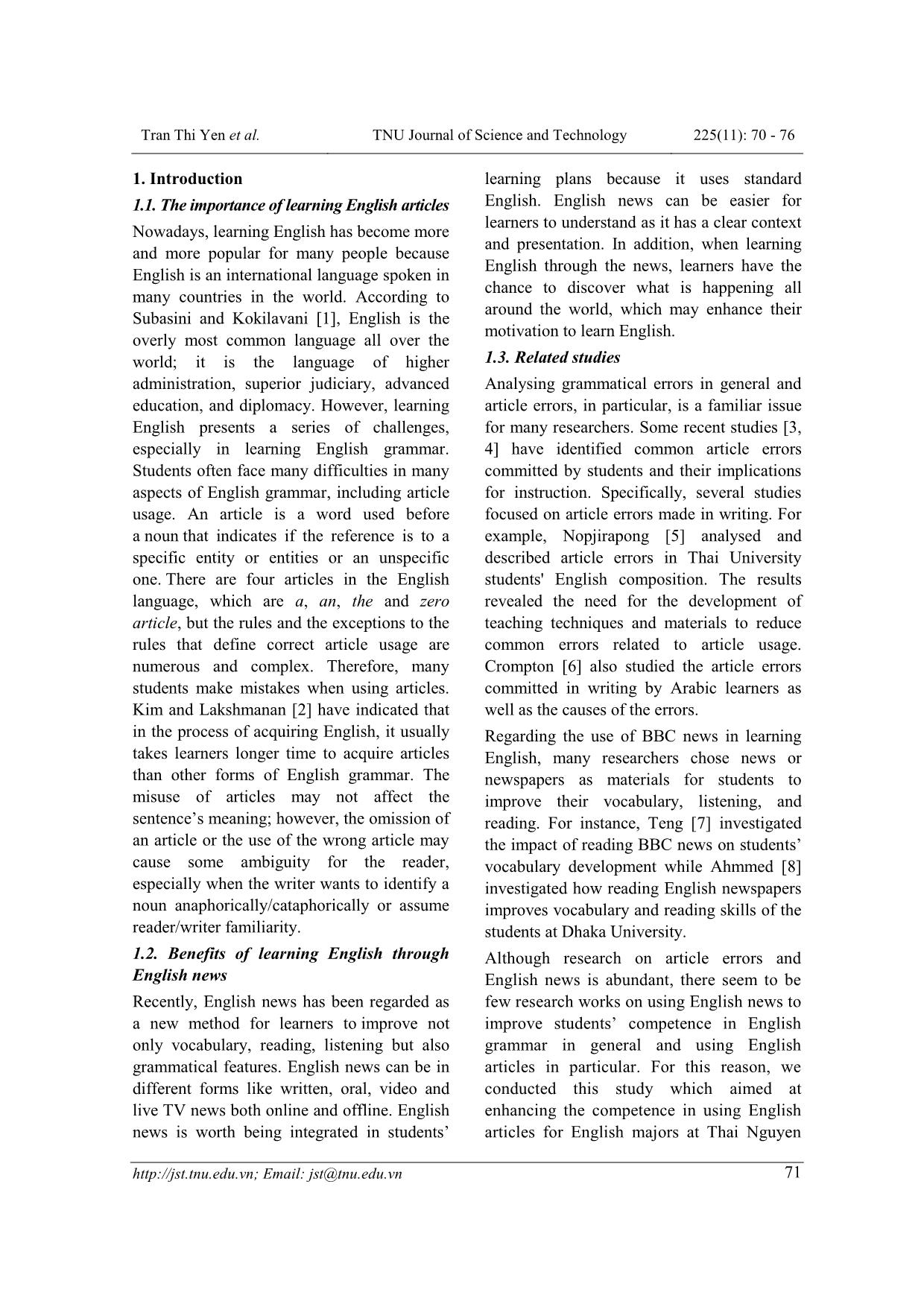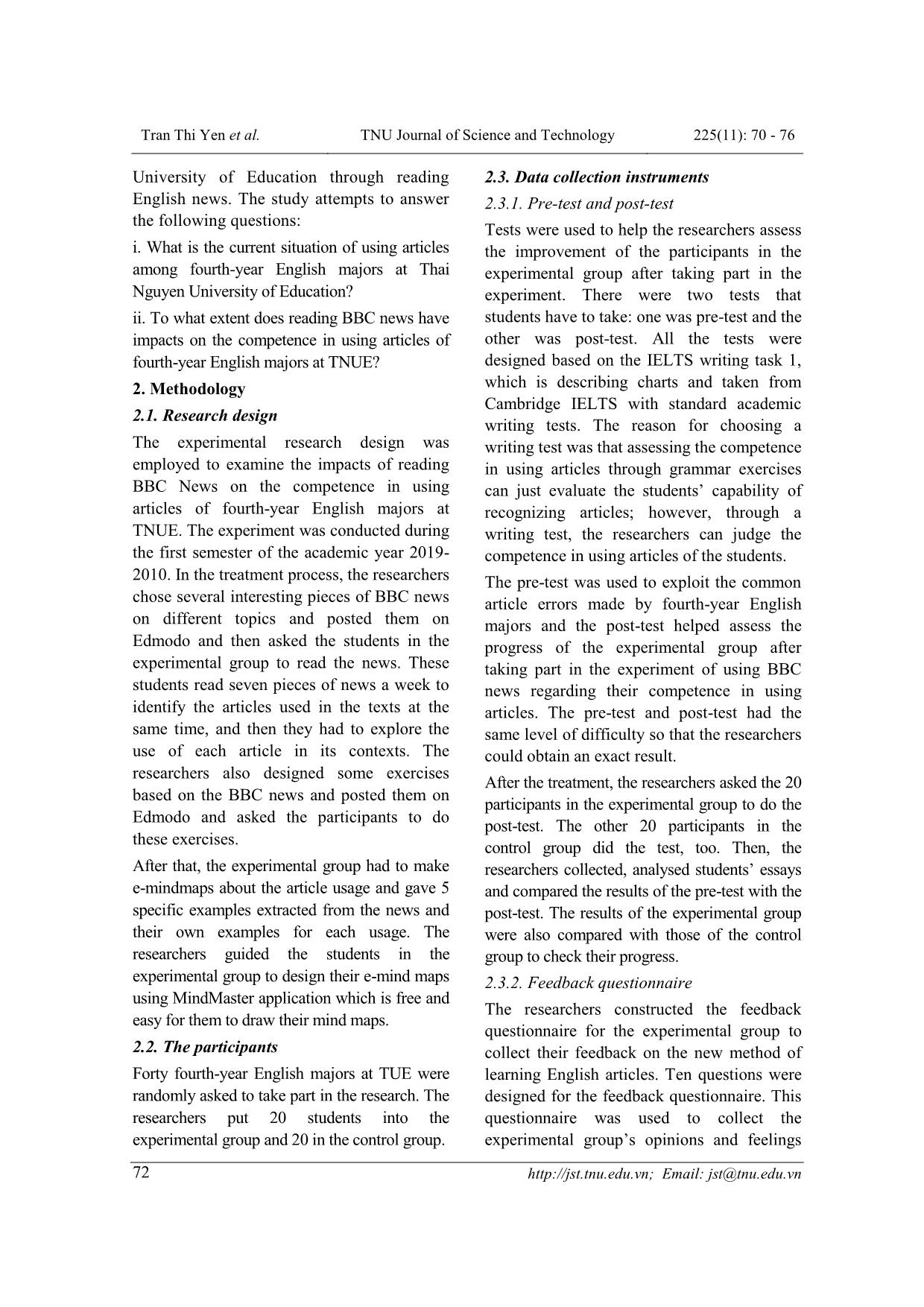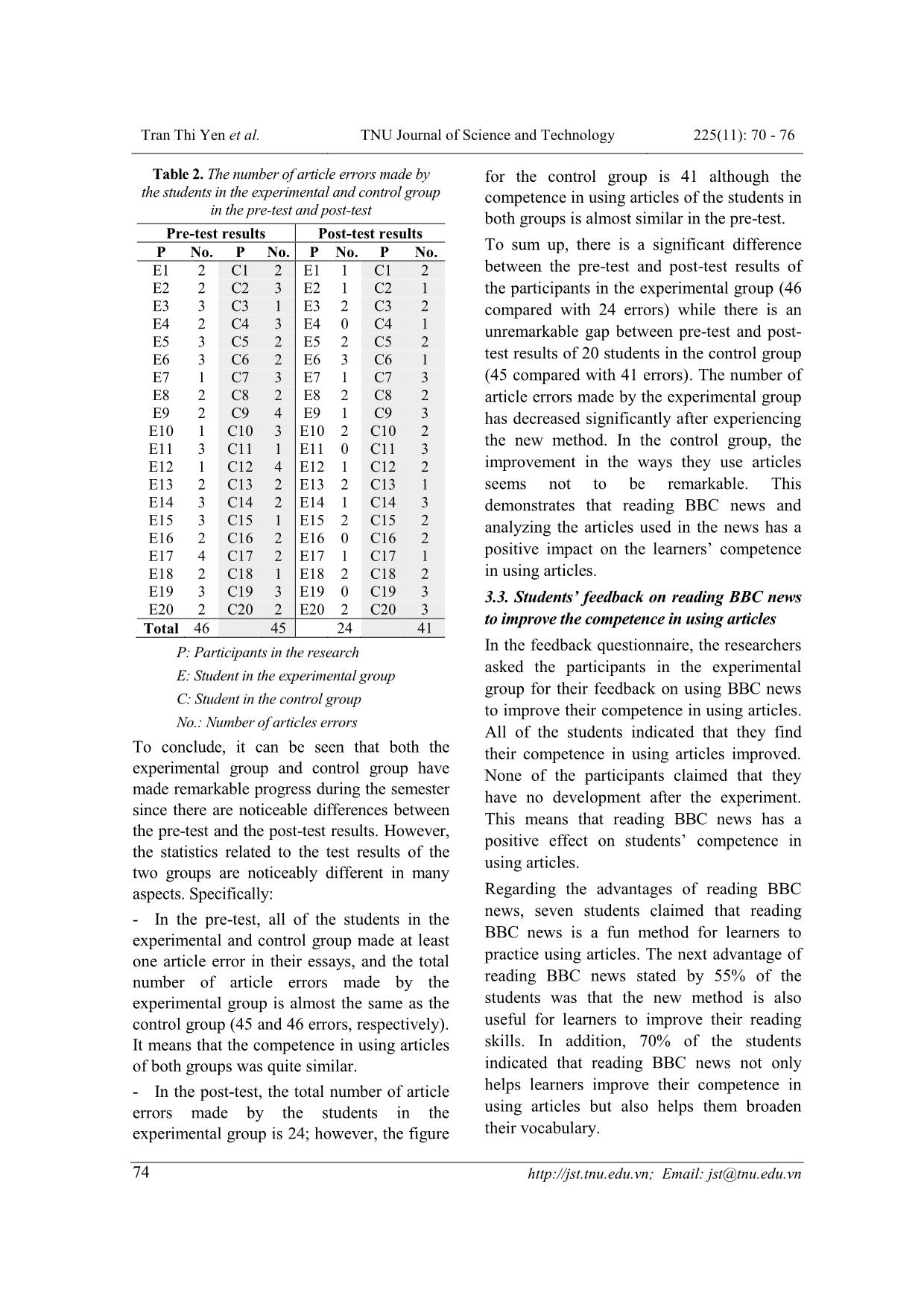Enhancing the competence in using articles for English majors through reading BBC News
The study aims to enhance the competence in using English articles for English majors at Thai
Nguyen University of Education through reading English news. Forty students were chosen
randomly; 20 of them were assigned to the experimental group and the others were put into the
control group. The authors studied and analyzed sixty essays written by 60 forth-year English
majors at Thai Nguyen University of Education in the first semester of the academic year 2019-
2020 in order to identify and categorize article errors. Besides, the experimental group were asked
to read one piece of news a day and at the same time identify the articles used in the texts, and then
they had to decide the use of each article in its contexts. After that, the experimental group had to
make their own e-mindmaps about the article usage and give 5 specific examples extracted from
the news and their own examples for each usage. The findings of the research indicated that the
number of article errors made by the experimental group decreased significantly while in the
control group, the number of article errors decreased unremarkably. This demonstrates that reading
BBC news has a positive impact on improving English majors‟ competence in using articles.

Trang 1

Trang 2

Trang 3

Trang 4

Trang 5

Trang 6

Trang 7
Tóm tắt nội dung tài liệu: Enhancing the competence in using articles for English majors through reading BBC News

e errors made by fourth-year English majors at TNUE, the researchers asked the participants to write an essay of IELTS writing task 1 which is describing charts. After the students finished their essays, the researchers collected and analysed these essays to study the common article errors made by these students Table 1. Students’ common article errors Common errors No. % Omission of „the‟ before the decades 15 21 Omission of „the‟ before superlatives 5 5 „the‟ used in stead of ∅ before plural nouns 13 18 Omission of „the‟ before a defining relative clause 6 7 Omission of „the‟ before nouns made particular in context 9 15 Table 1 presents the students‟ common article errors. It can be seen that fourth-year English majors at TNUE have some misunderstanding while using articles. The table shows two kinds of article errors: omissions and substitutions of articles. The data indicates that the omission of articles was the most frequent error. Eleven students omitted article „the‟ before the decades and this error was repeated 21 times in their essays. The number of students omitting „the‟ before superlatives comparison is eight. In addition, the omission of „the‟ before nouns made particular in 225(11): 70 - 76 context was made by six students and the frequency of the error is 9 times in students‟ essays. Five students forgot using „the‟ before a defining relative clause. For the substitution of articles, the article error made by the biggest number of the students is that they use „the‟ instead of „∅‟ before plural nouns. The frequency of this error is 25 times. 3.2. The impacts of reading BBC News on the competence in using articles of fourth-year English majors at TNUE To assess the impact of reading BBC news on enhancing the competence in using articles, the researchers analyzed the students‟ essays to identify the number of article errors made by the experiental group and control group in the pre-test and post-test, and compared the results as well as the progress of these students. Table 2 presents the number of article errors made by the students in the experimental and control group in the pre-test and post-test. As can be seen in the table, in the pre-test, it is clear that all the students in the experimental and control group made article errors in their essays. Moreover, seven students in the control group and seven students in the experimental group made more than 2 article errors in their essays. The total number of article errors made by the experimental group and the control group is 46 and 45, respectively. In the post-test, it can be seen that most of the students in the experimental group made under 2 article errors in their essays. Furthermore, four of them did not make any article errors in their writing test. There was only one student making 3 article errors in the essay. The total number of errors made by the experimental group is 24. Meanwhile, in the control group, it is clear that all the students made article errors in their essays. Moreover, the number of student making more than 2 article errors in their essays is 6. The total number of article errors is 41. Tran Thi Yen et al. TNU Journal of Science and Technology Email: jst@tnu.edu.vn 74 Table 2. The number of article errors made by the students in the experimental and control group in the pre-test and post-test Pre-test results Post-test results P No. P No. P No. P No. E1 2 C1 2 E1 1 C1 2 E2 2 C2 3 E2 1 C2 1 E3 3 C3 1 E3 2 C3 2 E4 2 C4 3 E4 0 C4 1 E5 3 C5 2 E5 2 C5 2 E6 3 C6 2 E6 3 C6 1 E7 1 C7 3 E7 1 C7 3 E8 2 C8 2 E8 2 C8 2 E9 2 C9 4 E9 1 C9 3 E10 1 C10 3 E10 2 C10 2 E11 3 C11 1 E11 0 C11 3 E12 1 C12 4 E12 1 C12 2 E13 2 C13 2 E13 2 C13 1 E14 3 C14 2 E14 1 C14 3 E15 3 C15 1 E15 2 C15 2 E16 2 C16 2 E16 0 C16 2 E17 4 C17 2 E17 1 C17 1 E18 2 C18 1 E18 2 C18 2 E19 3 C19 3 E19 0 C19 3 E20 2 C20 2 E20 2 C20 3 Total 46 45 24 41 P: Participants in the research E: Student in the experimental group C: Student in the control group No.: Number of articles errors To conclude, it can be seen that both the experimental group and control group have made remarkable progress during the semester since there are noticeable differences between the pre-test and the post-test results. However, the statistics related to the test results of the two groups are noticeably different in many aspects. Specifically: - In the pre-test, all of the students in the experimental and control group made at least one article error in their essays, and the total number of article errors made by the experimental group is almost the same as the control group (45 and 46 errors, respectively). It means that the competence in using articles of both groups was quite similar. - In the post-test, the total number of article errors made by the students in the experimental group is 24; however, the figure 225(11): 70 - 76 for the control group is 41 although the competence in using articles of the students in both groups is almost similar in the pre-test. To sum up, there is a significant difference between the pre-test and post-test results of the participants in the experimental group (46 compared with 24 errors) while there is an unremarkable gap between pre-test and post- test results of 20 students in the control group (45 compared with 41 errors). The number of article errors made by the experimental group has decreased significantly after experiencing the new method. In the control group, the improvement in the ways they use articles seems not to be remarkable. This demonstrates that reading BBC news and analyzing the articles used in the news has a positive impact on the learners‟ competence in using articles. 3.3. Students’ feedback on reading BBC news to improve the competence in using articles In the feedback questionnaire, the researchers asked the participants in the experimental group for their feedback on using BBC news to improve their competence in using articles. All of the students indicated that they find their competence in using articles improved. None of the participants claimed that they have no development after the experiment. This means that reading BBC news has a positive effect on students‟ competence in using articles. Regarding the advantages of reading BBC news, seven students claimed that reading BBC news is a fun method for learners to practice using articles. The next advantage of reading BBC news stated by 55% of the students was that the new method is also useful for learners to improve their reading skills. In addition, 70% of the students indicated that reading BBC news not only helps learners improve their competence in using articles but also helps them broaden their vocabulary. Tran Thi Yen et al. TNU Journal of Science and Technology Email: jst@tnu.edu.vn Additionally, after experiencing using e- mind maps to learn and memorize article usages, the researchers asked the students about the advantages of using e-mind maps. According to the data attained from the questionnaire, most of the students (80%) indicated that e-mind maps help them remember the use of articles more easily and longer. Besides, eleven students answered that using e-mind maps helped them increase their creativity when generating ideas for writing. 45% of the students claimed that they can improve their memory and retention by using e-mind maps. In addition, 30% of the students responded that using e-mind maps helped increase their interest because of its numerous models and colors. 4. Pedagogical implications 4.1. Pedagogical implications for students The findings from the present study imply that reading BBC news and analysing the articles used in the news at the same time has a positive impact on the learners‟ competence in using articles. To make the most of BBC news in enhancing the competence in using articles for students, the researchers would like to suggest the process of reading the news and master the articles used in the news effectively. - Firstly, choose your favourite topics from some academic sources of news (E.g. BBC News; VOA news; CNN news...) - Read the news, identify and underline the articles used in the texts at the same time, and then decide the use of each article in its contexts. - After that, note down the use of the articles with some examples extracted from the news. - Finally, make your examples of articles so that you can remember the article usages longer. One of the most effective ways to learn and remember the use of articles is using e- mindmaps. E-mindmaps are an active learning strategy that is useful for enhancing memory, generating ideas, and 225(11): 70 - 76 organizing information. In this way, learners can read, retrieve information, and connect concepts through lines or arrows that represent the relation of concepts by words or phrases written on the lines connecting the two concepts. Moreover, e- mindmaps use lines, symbols, words, colors and images which can raise learners‟ interest and inspiration. Some useful and effective applications of e- mindmaps suggested by the researchers are MindMaster, SimpleMind, Edraw Mind Map, Open Mind, etc. 4.2. Pedagogical implications for teachers There is a danger of putting students off reading newspapers if articles are used in the same way as course books, with tedious comprehension activities. If used in a more inspiring way, newspapers can help students to develop not only reading skills but also writing, grammar, vocabulary and speaking skills. Below are some tips and activities which the researchers believe can help. Integrate English news reading section into the lesson plans and use English news to design learning activities and exercises. Utilize different sources of English news like BBC News, VOA news, and CNN news to satisfy the students' tastes. Choose articles and topics which are appealing and relevant to the students. Motivate students to read English news not only inside but also outside the classroom. Discuss with the students about the benefits of reading English news. It may be also helpful to share reading strategies with them. For instance, teachers can hold class discussions on how to use a dictionary effectively, what kind of dictionary to use when reading English news online and offline, how to take notes, what piece of information to take note of, and what reading strategies to employ. 75 Tran Thi Yen et al. TNU Journal of Science and Technology 225(11): 70 - 76 Email: jst@tnu.edu.vn 76 5. Conclusion The results of the study can be summarized as follows: Firstly, for the first research question, it is clear that a large number of students make article errors while writing and one of the commonest article errors made by the fourth-year English majors is the omission of articles. As for the second research question, it is clear that there is a big difference between the pre-test and post-test results of the participants in the experimental group; however, there is an unremarkable gap between pre-test and post-test results of the 20 students in the control group although the competence in using articles of the two groups is almost similar in the pre-test. This is to say, the number of article errors made by the students in the experimental group has decreased significantly after experiencing the new method. In the control group, the improvement in the ways they use articles seems not to be remarkable. The number of article errors made by the participants in the control group decreased unremarkably. This demonstrates that reading BBC news and analysing the articles used in the news at the same time has a positive impact on the learners‟ competence in using articles. Finally, by analysing the questionnaire responses gathered, the researchers realised that the new method helped raise students‟ interest and desire to develop the competence in using articles. In other words, they still keep a positive attitude and will continue to use the new method as a helpful tool to master articles usages. Additionally, the participants after experiencing using e-mind maps to learn and memorise the use of articles expressed positive attitudes toward the new method. They found that using e-mind maps not only helps them remember the use of articles more easily and longer but also helps them increase their creativity when brainstorming new ideas for their essays. Furthermore, using e-mind maps helps students develop their memory and retention as well as increase their interests with its numerous models and colors. In conclusion, the researchers have made some efficient suggestions on ways to develop the competence in using articles. Hopefully, the study might be useful for students to master the use of articles and use them correctly. REFERENCES [1]. M. Subasini and B. Kokilavani, “Significance of grammar in technical English,” International Journal of English Literature and Culture, vol. 13, pp. 56-58, 2013. [2]. K. Kim and U. Lakshmanan, “L2 article semantics and second language processing,” In Proc. The 9th generative approaches to second language acquisition conference (GALANA), 2007, pp. 103-117. [3]. M. Alhaysony, “An analysis of article errors among Saudi Female EFL students: A case study,” Asian Social Science, vol. 12, no. 8, pp. 55-66, 2012. [4]. J. Gnanaseelan, “The errors in the use of article in business letter writing in English: A case study of the Business Management Students of Vavuniya Campus, Sri Lanka,” In Proc. The Third International Symposium, SEUSL: 6-7 July 2013, pp. 95-107. [5]. R. Nopjirapong, “An Analysis of Article Errors in Thai University Students' Composition,” Unpublished Master of Arts thesis, Srinakarinwirot University, Bangkok, Thailand, 2011. [6]. P. Crompton, “Article Errors in the English Writing of Advanced L1 Arabic Learners: The Role of Transfer,” Asian EFL Journal: Professional Teaching Articles, vol. 50, pp. 4- 34, 2011. [7]. F. Teng, “EFL Vocabulary Learning through Reading BBC News: An Analysis Based on the Involvement Load Hypothesis,” English as a Global Language Education (EaGLE) Journal, vol. 1, no. 2, pp. 63-90, 2015. [8]. R. Ahmmed, “Effectiveness of Reading English Newspapers for Improving Vocabulary and Reading Skills of Students of Dhaka University,” The Millennium University Journal, vol. 1, no. 1, pp. 68-76, 2016.
File đính kèm:
 enhancing_the_competence_in_using_articles_for_english_major.pdf
enhancing_the_competence_in_using_articles_for_english_major.pdf

